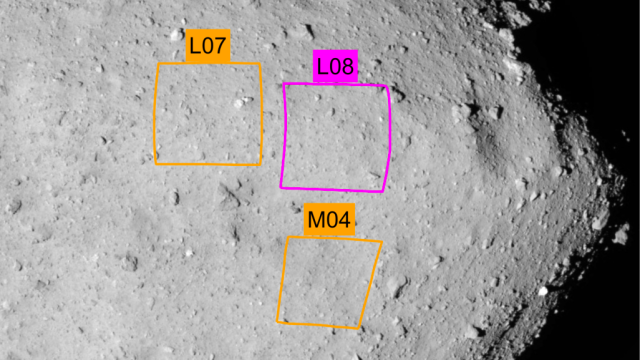The Japan Aerospace Exploration Agency (JAXA) has announced where its Hayabusa2 spacecraft will attempt a landing on the asteroid Ryugu.
Hayabusa2 launched in December 2014 with the goal of bringing a sample of an asteroid back to Earth. Its target is Ryugu, a 3000-meter-wide asteroid containing water and organic molecules — the building blocks of our own planet.
The spacecraft has been approaching the asteroid for a few months and now orbits just a few miles above the body’s surface. Hayabusa2 will hopefully return to Earth with a sample of Ryugu in late 2020.
JAXA held an all-day landing site selection conference last week, where it selected the sites: L08 (in pink in the image above) for Hayabusa2’s landing site, L07 and M04 for backup landing sites, as well as landing spots for the MASCOT suite of scientific instruments and the MINERVA-II-1 container, which contains two identical rovers.
Here’s the image below. Notice that Ryugu looks flipped compared to other images of the rock; that’s because normally, the images are presented to the public with Earth’s North Pole facing up — in other words, how Ryugu would look from Earth. Ryugu rotates the opposite direction that the Earth does, so turning the image 180 degrees puts the asteroid’s own North Pole on top.
How did JAXA determine the landing locations for Hayabusa2? The sites are flat spots within 200m of Ryugu’s equator, with an average slope less than 30 degrees, a flat region with a 100m diameter, boulders less than 50cm high, and a temperature less than 97°C. These conditions are considered most ideal for Hayabusa2’s construction, including the direction of its solar panels, the length of its sampling device, and its optimal operating temperature.
Picking the site required analysing and modelling Ryugu’s shape, measuring the density of boulders, and determining at the asteroid’s temperatures. Selecting locations for the other instruments took additional work.
But it the mission remains precarious. “We learned that that asteroid is not friendly to us, so [landing is] not as easy as we had supposed when we were planning the mission,” Masaki Fujimoto, Deputy Director General at JAXA’s Institute of Space and Astronautical Science, told Mika McKinnon.
According to JAXA, the 590kg Hayabusa2 will perform touchdown rehearsals on September 12 and again in mid-October, then touch down for the first time in late October. MINERVA-II-1 will operate on September 20 to 21, and MASCOT from October 2 to 4. All dates are subject to change.
Once Haybusa2 reaches Ryugu, it will blast the surface to kick up dust and grab samples below the asteroid’s surface, which it will then collect in a capsule. The materials that the scientists hope to sample are distributed around the planet, so no matter where they land, they’ll get the samples they want, reports Mika McKinnon.
This is exciting stuff — we’ve reported on some of humanity’s previous attempts to land on and collect samples from asteroid, which you can read all about here.
Cross your fingers!
[h/t Mika McKinnon]
